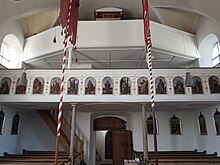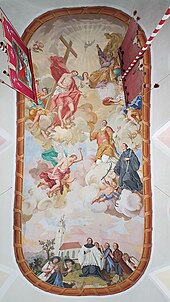St. Stephan (Riegsee)
The Roman Catholic branch church St. Stephan stands on the banks of the Riegsee in the municipality of the same name in the Upper Bavarian district of Garmisch-Partenkirchen . The listed church belongs as part of the parish of St. Georg Aidling to the Benediktbeuern deanery of the diocese of Augsburg . The address is Am Kirchplatz 4 .
history
The Romanesque parts of the tower suggest that it was built between 1000 and 1200.
From a parish rochse century is the 13th Pähler Dean's Office Directory reported. In 1246 a dispute broke out between the Habach Monastery and Count Heinrich and Berthold von Eschenlohe-Lichtenegg over the rights to this parish . By a bull by Pope Innocent VIII in 1491, Riegsee was placed under the Habach Canon Monastery. The parish of Riegsee also included Egling , Guglhör , Froschhausen , Lothdorf and Perlach . In the process of secularization in Bavaria the Riegseer parish was in 1804 the parish Murnau slammed, 1816 finally came the Umpfarrung after Aidling.
The church was built in the second half of the 15th century and redesigned in Baroque style in 1740 . In 1965 the interior was renovated and the side altars were reduced in size. The whole body relic of St. Generosus ran out of space and was parked in the church tower, where it was rediscovered before 2010 and was put up again to the right of the altar in October after its restoration.
Description and equipment
The church tower with a mansard roof is connected to the south of the baroque hall church . The choir has moved in a little.
The image of the high altar shows the stoning of St. Stephen , it was painted in 1657. The circular painting above represents St. Anna with her daughter Maria . At the base of the vault there are six medallions that refer to the church patron Stephanus.
The ceiling frescoes painted in 1792 are by Franz Kirzinger. On the parapet of the gallery Jesus with the twelve apostles represented, they were from Tölzer painter Adam Anton fat taken .
The full body relic of St. Generosus was recovered from the Calixtus catacomb in Rome in 1749 and brought back to his hometown by a lake from Riegsee. It is unclear whether this is actually a saint, because at the time of its rescue all those buried in the catacombs were considered martyrs . It is now known that the common people also found their final resting place there.
The church is surrounded by a plastered cemetery wall, which probably dates from the 18th century.
organ
The Munich organ builder Joseph Frosch built a new organ in St. Stephan in 1847 with five stops on a manual and pedal . The instrument was repaired by Balthasar Pröbstl in 1858 and has had the following disposition since the renovation by Josef Garhammer in 1979 :
|
|
||||||||||||||||||||||
- Coupling : M / P
Web links
Individual evidence
- ↑ a b c d List of monuments for Riegsee (PDF) at the Bavarian State Office for Monument Preservation (PDF; 127 kB) p. 1, accessed on June 25, 2018.
- ↑ St. Stephan - Riegsee branch. In: bistum-augsburg.de. Retrieved June 25, 2018 .
- ↑ a b c St. Stephan Riegsee. In: st-nikolaus-murnau.de. Retrieved June 25, 2018 .
- ↑ a b Torn from oblivion. In: Merkur.de. September 7, 2012, accessed March 25, 2018 .
- ↑ Michael Bernhard (Ed.): Organ database Bavaria online. Record 23934. 2009. Retrieved March 2, 2020.
Coordinates: 47 ° 41 '53.6 " N , 11 ° 13' 59.3" E



